Midpoint of a Line Segment
The midpoint of a line segment AB is the point that lies exactly halfway between the endpoints A and B.

For any line segment of non-zero length, there is exactly one midpoint that divides it into two equal segments.
For instance, consider the line segment AB.

This segment consists of an infinite number of points. However, only one point can divide it into two congruent segments - meaning two segments of equal length.
In this case, the midpoint is point C.

Point C divides the segment AB into two segments, AC and BC, which are congruent to each other.
How do you find the midpoint of a segment? To find the midpoint of a segment, simply use a compass to draw two arcs centered at the endpoints of the segment. Make sure the radius is greater than half the segment's length. The intersections of the arcs will give you two points, D and E, on the line that intersects the segment AB at its midpoint C.
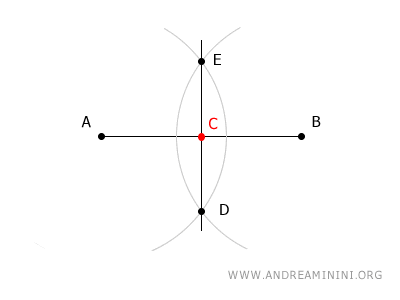
Given two points in the plane, $ A(x_A;y_A) $ and $ B(x_B;y_B) $, which represent the endpoints of a segment AB, the midpoint M of the segment has the following coordinates:
$$ x_M = \frac{x_A+x_B}{2} $$
$$ y_M = \frac{y_A+y_B}{2} $$
The coordinates of the midpoint M are simply the averages of the x-coordinates and y-coordinates of the endpoints.
How to Calculate the Midpoint in Analytic Geometry
The coordinates M(xM;yM) of the midpoint M of a segment on the Cartesian plane are found by averaging the x-coordinates and y-coordinates of the endpoints A(xA;yA) and B(xB;yB).

The x-coordinate of the midpoint is the arithmetic mean of the x-coordinates of the segment's endpoints xA and xB.
$$ x_M = \frac{x_A+x_B}{2} $$
The y-coordinate of the midpoint is the arithmetic mean of the y-coordinates of the segment's endpoints yA and yB.
$$ y_M = \frac{y_A+y_B}{2} $$
Therefore, the midpoint of segment AB is located at $ (x_M, y_M) $.
What about in three-dimensional space?
If the segment AB lies in three-dimensional space, the same principle applies: calculate the average of the x-, y-, and z-coordinates of the endpoints A and B.
$$ x_M = \frac{x_A + x_B}{2} $$
$$ y_M = \frac{y_A + y_B}{2} $$
$$ z_M = \frac{z_A + z_B}{2} $$
In this case, the midpoint is given by the coordinates $ (x_M, y_M, z_M) $.
A Practical Example
Let's consider a segment AB with endpoints A(2;3) and B(6;5).
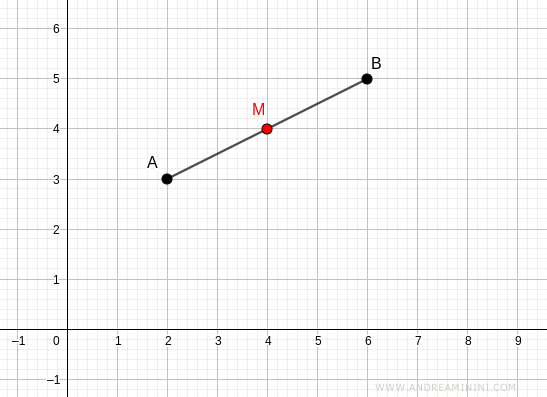
The coordinates of the midpoint are
$$ x_M = \frac{2+6}{2} = 4 $$
$$ y_M = \frac{3+5}{2} = 4 $$
The midpoint M of segment AB is located at (4;4).
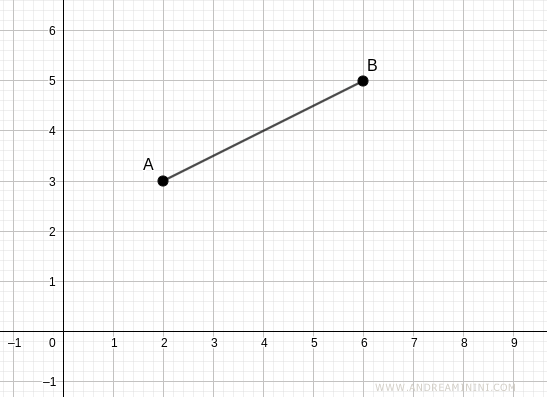
Example 2
Consider a segment AB with endpoints at A(2;1) and B(6;3).
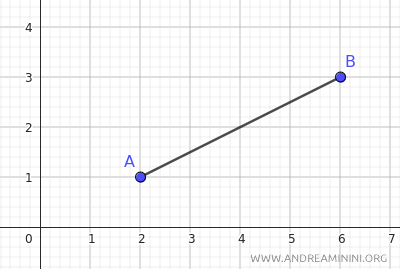
Point A is located at (2;1), so xA=2 and yA=1, while point B is at (6;3), so xB=6 and yB=3.
Let's calculate the coordinates of the midpoint M of segment AB:
$$ x_M = \frac{x_A+x_B}{2} = \frac{2+6}{2} = \frac{8}{2} = 4 $$
$$ y_M = \frac{y_A+y_B}{2} = \frac{1+3}{2} = \frac{4}{2} = 2 $$
The midpoint of the segment is at (xM;yM) = (4;2).
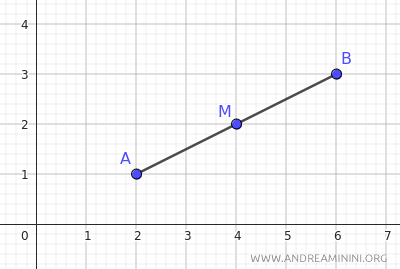
To verify, draw two arcs or circles with the same radius, as long as the radius is greater than the length of AM, centered at points A and B. Then draw a line connecting the points of intersection C and D of the arcs. The line CD will intersect segment AB at its midpoint M.
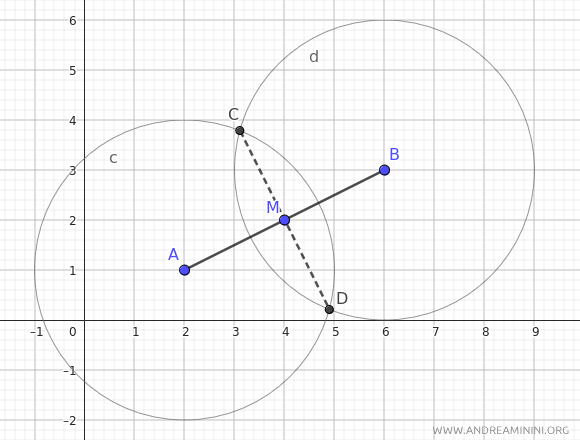
The Proof
Let’s consider the segment AB and its midpoint M.
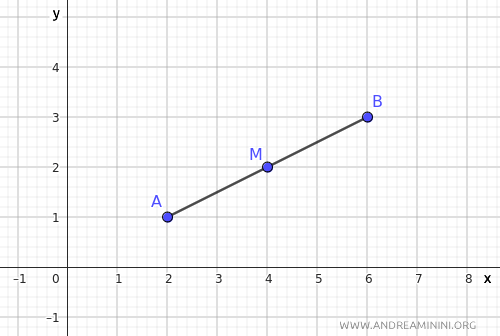
Now, draw lines parallel to the y-axis passing through points A, M, and B.
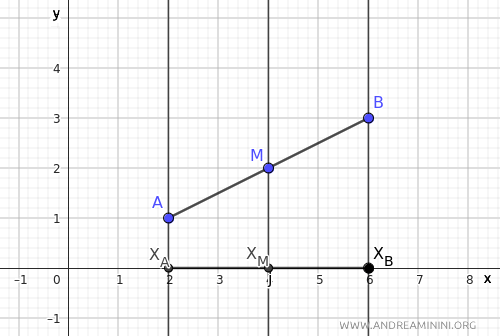
These three parallel lines are intersected by two transversals, AB and xAxB.
According to the theorem of improper bundles of parallel lines, congruent segments on one transversal correspond to congruent segments on the other transversal.
Since M is the midpoint of AB, segments AM and BM are congruent. This implies that the corresponding segments xAxM and xMxB are also congruent.
In other words, if point M bisects segment AB, it also bisects segment XAXB.
$$ | x_M - x_A | = | x_B - x_M | $$
Since xA<xM<xB, we can drop the absolute value.
$$ x_M - x_A = x_B - x_M $$
Solving for xM, we get:
$$ x_M + x_M = x_B + x_A $$
$$ 2x_M = x_B + x_A $$
$$ x_M = \frac{ x_B + x_A }{2} $$
This gives us the x-coordinate of the midpoint of segment AB.
Next, we repeat the same process to calculate the y-coordinate of midpoint M.
Draw three lines parallel to the x-axis passing through points A, B, and M.
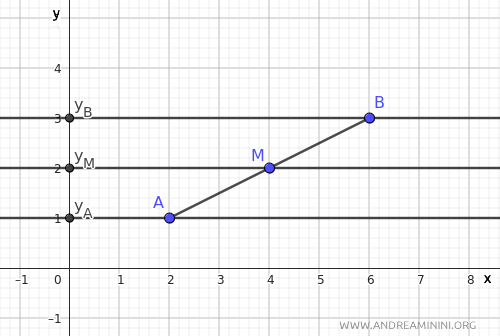
Again, these three parallel lines are intersected by two transversals, AB and yAyB.
According to the theorem of improper bundles of parallel lines, if segments AM and BM are congruent, then the corresponding segments yAyM and yMyB are also congruent.
In other words, if M bisects segment AB, it also bisects its projection yAyB on the y-axis.
$$ | y_M - y_A | = | y_B - y_M | $$
Since yA<yM<yB, we can drop the absolute value.
$$ y_M - y_A = y_B - y_M $$
Solving for yM, we get:
$$ y_M + y_M = y_B + y_A $$
$$ 2y_M = y_B + y_A $$
$$ y_M = \frac{ y_B + y_A }{2} $$
This gives us the y-coordinate of the midpoint of segment AB.
In summary, the coordinates of the midpoint M of segment AB are:
$$ x_M = \frac{ x_B + x_A }{2} $$
$$ y_M = \frac{ y_B + y_A }{2} $$
And so on.
